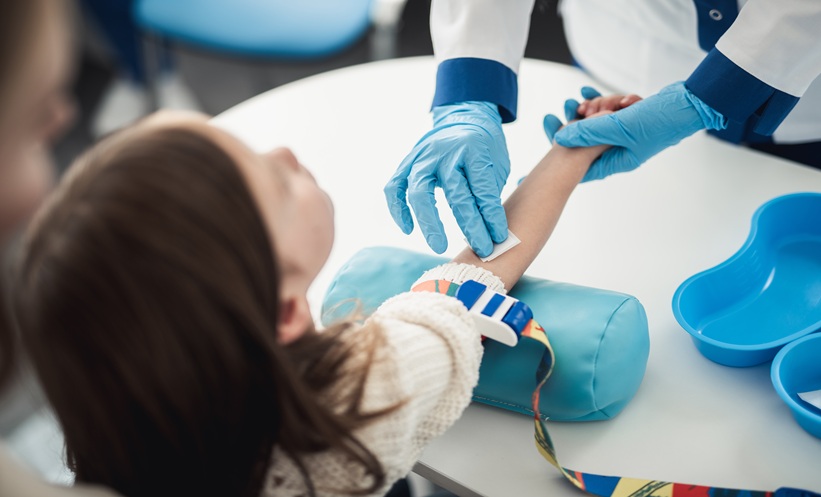AFTER a 3-year wait to meet in-person since the 2019 congress in Vienna, Austria, the European Association for the Study of Liver (EASL) International Liver Congress (ILC) took place in London, UK, from 22nd–26th June 2022. This year marked the 57th anniversary of the annual ILC event, and welcomed over 5,300 delegates on site, and over 1,300 virtually from 112 countries. The opening ceremony, led by Thomas Berg, General Secretary of EASL, took attendees through the array of fascinating sessions that ILC 2022 had on offer this year, including exclusive online content for hybrid viewers.
This year’s theme for the ILC congress centred around the association’s mission to ‘savour science together again’. Berg expressed the importance of coming together to inspire communities, and celebrate science in unison following the COVID-19 pandemic. With the ILC’s mission firmly conveyed, Berg showcased the variety of hepatology-focused sessions taking place, including the new addition of EASL’s studio sessions live from ILC 2022. The innovative format of these exclusive sessions allowed key experts in the field to interact with the audience, discussing daily data interpretations and their associated clinical consequences. Berg said, of the development of the studio sessions, “necessity is the mother of invention,” providing late-breaking updates to hepatologists around the globe. The year-round online content, which consists of 23 episodes, has already had over 29,000 views in 55 countries.
Berg introduced and handed over to Mario Rizzetto, Honorary President of ILC 2022. Rizzetto, who discovered hepatitis delta in 1977, began his presentation by addressing the impact of COVID-19 on EASL. Following the challenges introduced by the pandemic, the governing board chose energy and efficiency, and made the decision to go digital for the last two congresses. With ILC 2022 almost being back to “business as usual,” Rizzetto took the opportunity to reiterate the EASL mission, of ensuring that the cohesion and scientific identity of European hepatologists remains untarnished. Rizzetto went on share the visions and successes of EASL. Their 4-year strategy was implemented to take strides in (Euorpean Union (EU)-level advocacy, with a goal of raising awareness of liver health in Europe. The EASL Campus platform has been an essential cog in this mission; with over 6,000 resources, 20,000 registered users, and 1.2 million page views, it has been a turning point in extending global digital reach. Clinical practice guideline sessions were highlighted, providing key updates to the audience in conditions, including sclerosing cholangitis, haemochromatosis and pregnancy in liver disease, and cystic disease and hepatic encephalopathy.
The stage was handed over to patient representatives affiliated with EASL. Marko Korenjak, President, European Liver Patients’ Association, spoke during the ceremony of the importance and impact of patient groups, and how it is essential to retain both passion and compassion. Korenjak explained how improving patient education to be as skilled as possible can greatly improve the management of conditions, all whilst retaining patient perspective. Danjuma Adda, President, World Hepatitis Alliance (WHA), spoke of his personal experience of both living with hepatitis B, and having people close to him also diagnosed. Based in Nigeria, Adda explained how a cure for the disease is not currently affordable or accessible, which is a key factor in the WHA’s goal to lead the fight against hepatitis. This impactful section gave fascinating insights, and reiterated the importance of patient perspectives and representation.
Two members of the EASL Scientific Committee, Saskia van Mil and Virginia Hernández-Gea, presented this year’s award ceremony. The EASL 2022 Emerging Leader Award recognises the outstanding achievements of young fellows. This year, Salavatore Piano, Assistant Professor, University of Padua, Italy, and María Jesús Perugorria, Principal Investigator in the Liver Diseases Group, Biodonostia Health Research Institute, San Sebastian, Spain, received this award for their respective research contributions. The EASL Nurses and Allied Health Professions Rising Star Award was presented to Catherine Wood, Hepatology Clinical Nurse Specialist, Royal Cornwall Hospital NHS Trust, UK, for her dedication to improving healthcare for all patients, especially in the context of non-alcoholic fatty liver disease.
Berg concluded the session with a message to all attendees, wishing them an enjoyable congress whilst reminding attendees of the most engaging and interactive sessions on offer. With numerous networking sessions, interactive ePosters, and general assembly meetings, it is safe to say that this year’s ILC 2022 congress successfully provided the means for hepatologists across the globe to ‘savour science together’. Expert-led symposia covered emerging topics in the discipline, including hepatitis, cirrhosis, and optimal diagnosing strategies for liver disease. Our in-house feature provides an overview of a fascinating session on the critical care management of acute decompensation of cirrhosis, alongside standout ILC press releases, and an interview with Aleksander Krag, EASL Secretary General 2022.
We were delighted to form a part of the in-person audience at this year’s ILC 2022 congress, and look forward to next year’s event which is taking place once again in Vienna, Austria. For now, enjoy the scientific highlights presented in our comprehensive review of this compelling congress.
Pre-emptive Combination Therapy Can Prevent Hepatitis C Viral Infection in Recipients of Viraemic Grafts
EIGHT doses of combination therapy could prevent post-transplant complications associated with HCV transmission in patients receiving viraemic transplants. The combination therapy studied was glecaprevir/pibrentasivir (G/P) and ezetimibe, commencing on the day of surgery and continuing for 7 days after transplant of an hepatitis C virus (HCV) viraemic, non-liver solid organ into HCV seronegative recipients.
The prospective, multicentre, open-label study, presented on 23rd June 2022 by Bashar Aqel of the Mayo Clinic College of Medicine in Phoenix, Arizona, USA, at ILC 2022, assessed the efficacy and cost-effectiveness of pre-emptive combination of G/P plus ezetemibe therapy in 38 HCV-seronegative patients receiving non-liver, HCV-viraemic, solid organ transplants.
Of the 38 recipients, 63% were male and the median age was 60 years. Thirty-two patients received a kidney transplant, two received a kidney and pancreas transplant, three received a heart transplant, and one received a heart and kidney transplant.
To assess response to treatment, HCV RNA levels were monitored for 24 weeks post-transplant and patients were followed-up for 1 year to determine rates of patient and graft survival.
All recipients completed the eight-dose treatment course, which was well-tolerated. Post-operative monitoring revealed that 28 patients had transient viraemia in the initial 2 weeks post-transplant, but all 38 patients had undetectable HCV RNA levels by Week 4. These RNA levels remained undetectable at 13 weeks. One recipient died 65 days post-surgery secondary to acute subdural haematoma.
In terms of cost-effectiveness, Aqel reported that the cost of pre-emptive combination therapy was significantly less than standard therapy given in response to post-operative complications associated with HCV transmission.
Aqel concluded that combination therapy with G/P and ezetemibe was effective at preventing HCV infection secondary to transplant of HCV viraemic non-liver, solid organs in 100% of HCV seronegative recipients. Further to this, Aqel stated that the approach is cost-effective and could potentially eliminate the risk of post-transplant complications associated with HCV transmission. These findings could increase use of HCV viraemic grafts, which could, in turn, lead to reduced patient waiting times.
Eliminating Viral Hepatitis C From Prisons in England
HIGH intensity test and treat (HITT) programme was a hit in English prisons. The programme, the result of a collaboration between the National Health Service (NHS) and the Hepatitis C Trust, a patient-led charity for those with viral hepatitis C (HCV), was presented at the EASL’s ILC 2022, with data that highlighted the importance of the testing and treating inmates and the prevalence of the infection in different establishments in England.
Successfully completed in 34 institutions in England (7 female prisons and 27 male prisons), the HITT programme saw NHS staff, nurses, and peers who have lived experience of HCV and prison life venture into prisons. Between June 2019 and September 2021, they offered 23,388 inmates prison-wing-based testing with point-of-care antibody tests, which were followed by blood draws or dried blood spot testing for conformation of viraemia in those who tested positive for HCV antibodies.
Although the HITT programme was halted for 6–9 months due to the COVID-19 pandemic, where NHS staff, nurses, and peers could not enter prisons, 19,049 inmates agreed to testing. A total of 1,234 inmates tested positive for HCV antibodies. Of these, 175 then tested positive for the presence of HCV RNA. All individuals who were infected were offered therapy, often on the same day with HCV RNA testing and pan-genotypic medication, or with direct acting antivirals within 2 weeks of testing.
An analysis of the data showed that HCV is more prevalent in prisons for females and that different prisons had different infection rates. The programme highlighted that remand prisons had a higher prevalence of HCV than re-settlement prisons.
These results indicate that the HITT programme is invaluable to providing treatment to inmates, who are more likely to test positive for HCV than the general population, and to stop the infection from becoming worse. It also provided data for the prevalence of HCV in prisons and how it varies between the establishments.
Genetic Variation of Hepatocellular Carcinoma in Alcohol-Related Cirrhosis
GENETIC variation in telomerase reverse transcriptase modifies the risk of patients diagnosed with alcohol-related cirrhosis (ArC) developing hepatocellular carcinoma (HCC). HCC is the most common form of liver cancer, which is often seen in patients with chronic liver diseases, such as cirrhosis.
Patients with ArC have an annual risk of up to 2.9% of developing HCC. In previous research, some host genetic risk factors have been discovered, but these do not provide a full explanation for the majority of variances in occurrence.
Presented at the EASL’s ILC 2022, the aim of this study was to identify novel risk factors for HCC developing in patients with ArC.
The study was made up of a cohort of patients with ArC who developed HCC (cases: n=1,214), and another with ArC who did not have HCC (controls: n=1,866). These patients were located in Austria, Germany, Italy, Switzerland, and the UK. All patients were included in a two-stage genome-wide association study, which used a case-control design.
Researchers included a validation cohort made up of 1,520 individuals who misused alcohol, but had no evidence of liver disease. This cohort was included as a control regarding possible association effects of alcohol misuse. Researchers performed genotyping using both the Infinium®Global Screening Array (version 24v2; Illumina, San Diego, California, USA) and the OmniExpress Array (version 24v1-0a; Illumina).
The study confirmed two variants previously associated with HCC in patients who have ArC at a genome-wide significance. They also identified a novel locus rs2242652 in telomerase reverse transcriptase, which continued to be significant following correction for age, ancestry, BMI, sex, and Type 2 diabetes. To conclude, rs2242652 in telomerase reverse transcriptase is a novel protective factor against developing HCC in patients who have ArC.
Chronic Hepatitis B and Primary Liver Cancer: Is Ultrasound an Effective Surveillance Modality?
PATIENTS with chronic hepatitis B under surveillance for primary liver cancer (PLC), who have poor Ultrasound Liver Imaging Reporting and Data System (US LI-RADS) visualisation scores, have higher false negative rates and increased risk of PLC than those with good visualisation scores.
Chronic hepatitis B is a risk factor for PLC, particularly hepatocellular carcinoma (HCC); as a result of this, regular surveillance is performed for patients considered high-risk. Ultrasound is a standard imaging technique used in surveillance.
A cohort study presented on 25th June 2022 by lead study author Min Kyung Park of The Department of Internal Medicine and Liver Research at Seoul National University College of Medicine, Korea, Republic of South Korea, at ILC 2022 highlights that ultrasound may not be the optimal imaging modality for PLC surveillance in those with poorer visualisation scores.
The study included 2,002 patients with chronic hepatitis B under regular HCC surveillance, with the aim of assessing the efficacy of ultrasound for detection of PLC according to US LI-RADS visualisation scores.
Patients were stratified into visualisation scores A and B/C, with visualisation score A being best and C being worst. There were 972 patients with visualisation score A, 1,003 with visualisation score B, and 27 with visualisation score C. Once stratified, the researchers analysed the incidence of PLC and ultrasound false negatives. The median follow-up period was 75 months.
Of the 2,002 patients enrolled, 166 developed PLC (158 HCC, 8 other PLC). The researchers identified that those with visualisation scores B/C had a significantly higher risk (p<0.001) of developing PLC (2.41% /year) than those in visualisation group A (0.5% /year), as well as higher false negative rates with ultrasound surveillance (43.5% versus 20.0%). Furthermore, they found that very early-stage PLC was less likely to be picked up by ultrasound in visualisation group B/C.
The findings from this study infer that ultrasound may not be the optimal surveillance imaging modality for patients with poor US LI-RADS visualisation scores. The researchers recommended at ILC 2022 that CT or MRI could be considered as alternative surveillance techniques in this patient group.
Low-Carbohydrate, High-Fat Dietary Intervention for Non-alcoholic Fatty Liver Disease
OVER half (55%) of people with Type 2 diabetes also have non-alcoholic fatty liver disease (NAFLD). Glycaemic control predicts severity of hepatocyte ballooning and hepatic fibrosis in NAFLD. Although dietary interventions with low carbohydrates improve glycaemic control, the effect on NAFLD remains to be elucidated. Therefore, a team of researchers investigated the impact of a 6-month low-carbohydrate, high-fat diet on NAFLD. The effect of this dietary intervention was assessed by ≥2 points improvement in the NAFLD Activity Score (NAS). Results were presented at ILC 2022.
One hundred and eighty-five individuals with Type 2 diabetes were randomised 2:1 to a diet consisting of low carbohydrates and high fat or one comprising high carbohydrates and low fat. In both cases, non-calorie-restricted diets were used. The researchers performed liver biopsies and measured HbA1c at baseline and after 6 months.
In total, 165 of the randomised participants commenced the allocated intervention and were included in the analysis. After intervention, no significant difference was observed between the groups with respect to improvement of ≥2 points in NAS (p=0.587). Of note, a higher proportion of patients in the low-carbohydrate, high-fat group improved NAS with ≥1 point relative to the high-carbohydrate, low-fat group (70% and 49%, respectively; p=0.028). In addition, fewer in the low-carbohydrate, high-fat group experienced a worsening of NAS (1% versus 23% for the high-carbohydrate, low-fat group; p<0.001). Finally, those in the low-carbohydrate, high-fat group improved HbA1c with -9.5 versus -3.4 in the high-carbohydrate, low-fat group.
In conclusion, a 6-month non-calorie-restricted low-carbohydrate, high-fat diet was shown to improve NAS and HbA1c significantly more than a high-carbohydrate, low-fat diet among individuals with Type 2 diabetes.
The Global Burden and Aetiology of Chronic Liver Disease and Liver Cancer: Non–alcoholic Fatty Liver Disease as an Emerging Driver
THE BURDEN of chronic liver disease (CLD) and liver cancer (LC) has historically been attributed to alcohol-associated liver disease (ALD), chronic hepatitis B, and chronic hepatitis C viral infections.
However, new evidence presented at ILC 2022, 22nd–26th June, London, UK, by lead author James Paik, Betty and Guy Beatty Center for Integrated research, Inova Health System, Falls Church, Virginia, USA, and Center for Liver Disease, Department of Medicine, Inova Fairfax Medical Campus, Falls Church, Virginia, USA, reveals that non-alcoholic fatty liver disease (NAFLD) has become an emerging driver for the increasing incidence and prevalence of CLD and LC globally, between 2009 and 2019.
Using data obtained from the Global Burden of Disease Study 2019, the authors reviewed changes in incidence, prevalence, morbidity and mortality, and disability-adjusted life–years (DALYs) for LC and CLD over the preceding decade. With the data, the team calculated annual percentage change (APC) using the Joinpoint Regression Program, National Cancer Institute.
Prevalence and incidence both increased for LC and CLD during the period studied (LC: +33.7% and +30%; CLD: +22.7% and +14.8%, respectively). Deaths and DALYs also increased for both conditions. Analysis of the APC for LC death rate considered the impact of different aetiologies, with the greatest impact driven by NAFLD (APC +2.47%). NAFLD also had the greatest impact on CLD death rate (APC +1.33%), although the overall APC for CLD death rate decreased by 0.18% during the studied period.
Geographical variations in the aetiology and burden of LC and CLD were also reported. Central Latin America showed the highest APC increase in NAFLD and hepatitis B and C virus-related LC deaths; whereas, in the North American region, the highest APC increase in LC deaths was due to ALD.
The findings from this study showed increases in NAFLD and ALD driving the increasing burden of LC and CLD. This highlights how disease aetiology can change over time and the need to continually evaluate these factors to improve understanding.








